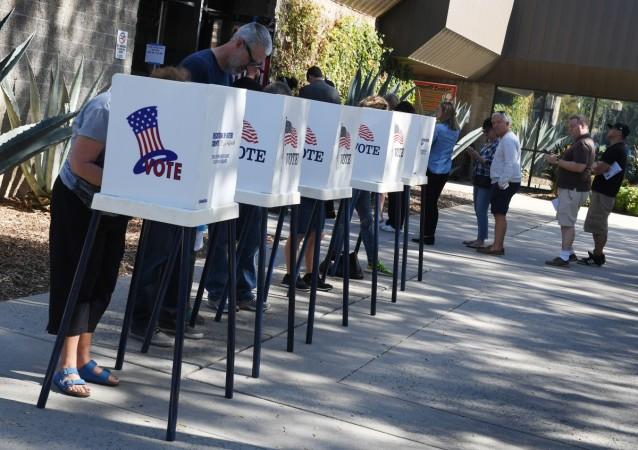
Come Tuesday, November 6, and the United States of America will go to polls for the much discussed mid-term elections.
The 2018's mid-term polls is being seen as a referendum not on the ballot but on the president himself. The election is being held two years after Donald Trump was elected and even though the president will not be on the ballot, the poll will outline his remaining presidency.
The polls will decide whether the House and Senate will continue to be controlled by Trump's Republican Party or the power will shift to the Democrats who may win control of one or both.
What are mid-term elections?
Mid-term elections in the US are general elections that are held in November every four years. It gets the name mid-term as it is held halfway through the president's four-year term of office.
The focus of these elections is the Congress, equivalent to the Parliament in many countries. It comprises the Senate (the upper house) and the House of Representatives (the lower house). There are a total of 100 seats in the Senate and 435 seats in the House of Representatives.
While senators serve a term of six years, representatives serve a two-year term. In tune, all the 435 representative seats go to polls this year, while 35 Senate seats are up for grabs.

In addition, 36 states and three territories of the US will elect governors and a few states are even voting for other issues. Florida will also decide if convicted felons, who have served time, should be given back their voting rights.
What's at stake?
The Republicans and Democrats are vying for the control of the Senate and the House. Fifty-one seats are needed for the control of Senate and 218 are needed for the House.
While the Republicans currently hold the majority in the House and the Senate, tables could turn if the Democrats win 23 seats to claim majority in the house and at least two seats to form a majority in the Senate. In case of a tie, vice president Mike Pence will be the tie-breaker.
Who is likely to win?
If history is any indication, the president's party usually loses seats in the mid-term elections, which were first held in 1934. Since then, the president's party has won seats just three times in the House and five times in the Senate.
As per opinion polls, Democrats have been fairing quite well in the campaigns and this could also reflect in the number of seats they gain. Generic ballot polling that keeps a track of which party voters may back shows that Democrats are currently leading in terms of supporters by 8 percent. While 42.4 percent people have said that they are backing Republicans, 50.5 percent have said they are with the Democrats.
The president's approval rating is also said to be a good indicator of how the polls may turn out and Trump's has been low since he assumed office. Currently his rating is around 42 percent, reported BBC.
Record number of female candidates
This midterm election is also witnessing a record number of female candidates running for the polls and is often being referred to as the "pink wave."

Michigan, one of the states that will also elect a govenor, has an all-female candidate list for the post. In addition, Michigan Democrat Rashida Tlaib is running unopposed and will be the first Muslim woman elected to Congress.
What happens if the Democrats win?
If the Democrats gain control of the House, Trump's powers to pass major legislations would weaken. In addition, several investigations into the Trump administration and its functioning could be reopened, including Russia's reported meddling into the 2016 presidential election, according to Fortune. Trump's tax bills have hit headlines in the last few weeks, and this too could be reviewed.
In case the Democrats win control of the Senate too, they will have a say in any Supreme Court appointments and additions to the president's cabinet.
Will the US witness another impeachment?
More number of Democrats in the Senate also means that Trump may have to worry about impeachment. A president can be impeached for "treason, bribery, or other high crimes or misdemeanours."
While most of the Democrats haven't openly discussed the president's impeachment, a few members are known to have proposed the move.
In case a majority of the House makes such a proposal in written, the Senate would then have to hold a trial. This would require a two-thirds majority, after which Trump could be impeached. However, the two-thirds majority would not be possible without the votes of the Republicans.
In case Trump is impeached, vice-president Mike Pence will then replace him.
When will the results be announced?
Polling in the 50 states starts at 8 am EST and the results will depend on how early voting in various states end. For instance, voting in states such as Indiana, Kentucky, Georgia, New Hampshire, Virginia, South Carolina and Vermont will close at 7 pm EST, whereas polls in California, Oregon, Washington and Hawaii go on until 11 pm EST.
In tune, results should start trickling in after 11 pm EST, with a more concrete numbers appearing by Wednesday, November 7 morning.
What happens after mid-term elections?
The focus will then shift to the 2020 presidential elections, the campaigning for which starts in 2019. Trump is expected to seek another term as the president and his Democrat challenger will be decided only after the primary elections that will start in January 2020.
The US will then go to presidential polls on November 3, 2020.









